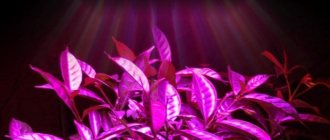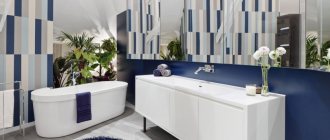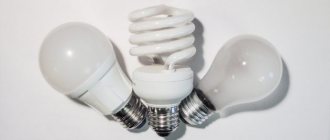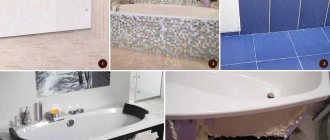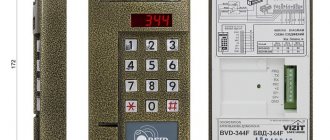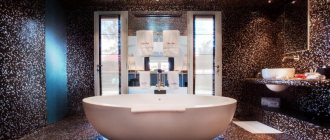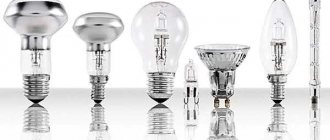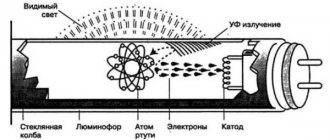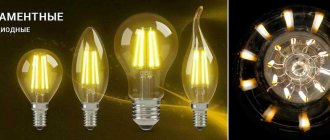What is LED lighting
Diode lighting is a method of supplying artificial light using energy-saving LED lamps. The technology has become widespread relatively recently, but has already earned recognition from interior designers.
With the help of LED devices it is easy to implement any lighting scenarios. The devices look attractive in the interior and are perfectly combined with the smart home system.
You can insert LED lamps into conventional lighting fixtures or immediately purchase LED devices. However, before choosing products, it is important to understand how they function.
Example of LED lighting in an apartment
Interesting lighting ideas
Thanks to the simple installation of LED sources and the flexibility of the material, you can highlight any area or detail of the room with soft, bright or colored light.
Interesting options for using LEDs:
- Window space - hidden curtain lighting.
- Arches, doorways, niches - lamps along the contour.
- Illumination of a kitchen island, table or bar counter.
- Illumination of mirrors, bathtubs, plumbing fixtures.
- Illumination of the kitchen apron, the lower part of the wall cabinets.
LEDs can be used to decorate indoor plants, highlight ceiling niches, highlight an aquarium, and bookshelves. There are many ideas on how to use LED sources in apartment lighting. An important rule is that the main lighting should be uniform and bright, contour and decorative lighting should be accent lighting. There is no need for extra lighting sources in the apartment; it is enough to install several powerful devices and correctly direct the flow of light.
Installation of LED strip and 5 mistakes when choosing (1 video)
Ice lighting in the interior (55 photos)
Design and principle of operation of LEDs
LEDs are devices created on the basis of semiconductor elements with an electron-hole junction. Devices emit light only when electric current passes through them.
One of the semiconductors is dominated by positive ions, the other by electrons. When a current passes through the point of their contact, recombination of elements occurs. As a result, excess energy appears, which is converted into light radiation.
Diodes emit rays in the green, blue and red spectrum. As a result of mixing these tones, a white glow is obtained. Depending on the type of lamp, the flows can be either warm or cold.
Standard LED lamp design:
- A board with diodes located on it.
- Radiator.
- Driver.
- Diffuser.
- Base.
- Flask of any shape.
- Lower and upper holders.
The most important element of the system is the driver, which is located in the base of the device. It is a combination of a transformer, capacitors and microcircuits. The cost of LED lighting sources depends on the quality of this part. The driver is used to convert alternating current into direct current and stabilize the incoming voltage. Another function is powering the LEDs.
The socket is a necessary element for connecting the lamp to the lamp socket. There are several types of parts, but the most common are pin and screw.
The radiator serves to remove heat from the LED crystals. The larger the part, the better the effect of its work.
The diffuser plays an important role in the system. It helps to evenly distribute light fluxes and protects the lamp body from moisture and dust.
Colored LEDs
Round LED lamp
What is LED?
Light source. It is a semiconductor material that emits light when current flows through it. The light emitted is in a narrow range of the spectrum, unlike an incandescent lamp, which has a wider spectrum. First developed in the 1960s, it is only in the last decade that LEDs have become widespread.
LEDs are semiconductor diodes, electronic devices that allow current to flow in only one direction. A diode is formed by combining two slightly different materials together to form a PN junction. In a PN junction, the P side contains excess positive charge ("holes" indicating missing electrons) and the N side contains excess negative charge (electrons).
- A semiconductor is a material whose electrical conductivity lies between a conductor and an insulator. The conductivity of semiconductors depends on temperature.
When a forward voltage is applied to a semiconductor element forming a PN junction (formerly called a junction), electrons move from the N region to the P region and holes move to the N region. Near the junction, electrons and holes combine. When this happens, energy is released in the form of light, which is emitted by the LED.
- PN junction - For LEDs, it is the part of the device where positive and negative charges combine to produce light.
LED is the most economical and efficient light source of the 4th generation. There are white and colored radiation. LEDs are used to produce LED lamps and other light sources, televisions, advertising screens, car side lights and much more.
LED lamps: pros and cons
To make a decision in favor of LED lighting, it is important to study the merits of light sources. Main advantages:
- Long service life: LED lamps can last up to 50,000 hours.
- Environmental friendliness and safety: no toxic components are used in the manufacture of lamps.
- Economical energy consumption: diode lamps require much less electricity than other lamps, but at the same time provide optimal illumination intensity.
- Housing strength: LED lamps will not break if accidentally dropped from a small height.
- Excellent light output parameters. The average luminous flux power is 50-100 Lm per 1 W.
- Optimal light spectrum: LEDs provide comfortable lighting similar to sunlight. For comparison: the color rendering index of natural streams is 100 units, LED lamps are 80-85.
LED lighting lamps are suitable for any room, including those with high humidity. The devices do not require maintenance or additional protection measures.
Important! The service life of devices does not depend on the frequency of switching off and switching on.
The disadvantages of LED lamps are much more difficult to identify. You can name one - relatively high cost. However, the disadvantage is compensated by reduced electricity consumption.
LED lamps in the interior of the apartment
Advantages and disadvantages
LED lamps have many advantages over incandescent, halogen and fluorescent lamps. Comparative properties are given in the table.
The advantages of LED include:
- Long service life. If all parameters specified by the manufacturer are observed, the LED lamp can operate for up to 50 thousand hours or even more. This is 50 times more than an incandescent lamp, 12.5 times more than a halogen lamp, and 3.3 times more than a fluorescent lamp.
- Maximum light output with minimal power consumption. Their light output is approximately two times higher than that of fluorescent lamps, 4-5 times higher than that of halogen lamps and 7-8 times higher than incandescent lamps. Accordingly, the energy consumption and power of LED lamps of the same luminous flux are less by the same amount.
- Large number of color temperatures.
- Environmental safety, no problems with disposal.
- Structural strength. The lamp can work even with a broken lens.
- Low heating during operation.
- Instant on (unlike fluorescent).
- The number of on-off cycles does not affect performance (unlike fluorescent ones).
- Beautiful appearance.
- Possibility of synchronization with smart home technology.
- The work does not depend on humidity and temperature changes.
- Reduced wiring requirements due to low power LED lamps.
LEDs are not without their drawbacks:
- High price. It is noticeably higher than other types of light sources. Manufacturers are working to reduce costs, but, unfortunately, this often comes at the expense of quality. The price reduction is due to the replacement of the driver with a power supply. After this, the LED lamp quickly fails.
- Sensitivity to changes in mains voltage. The driver levels out differences, so cheap models without a stabilizer quickly fail.
- Flickering (pulsation) of the light flux. Flickering is extremely dangerous for human vision. The optimal pulsation coefficient should not exceed 5%; it is dangerous to use more than 30% at home. Flickering depends on the quality of the design. The absence of a driver dramatically reduces the quality of light.
- A decrease in brightness during operation associated with the physical degradation of LEDs.
- High percentage of defects, especially among inexpensive lamps.
Application of LEDs: types of lighting
Due to their excellent performance parameters, LED lamps are suitable for use indoors and outdoors. Types of lighting:
- Apartment.
- Office.
- Trade.
- Industrial.
- Street.
- Spotlight.
- Emergency.
LED lighting is especially often installed in living rooms. Diode lamps can be present in any lamps: wall, ceiling, decorative. You can also use LED strips. They are good for illuminating interior items, furniture, multi-level ceilings, niches, and stairs.
Apartment lighting with LED lamps
Emission color of LED lamps
LED lamps can have different shades of light. To determine the parameters, there is a color range, the main indicators of which are indicated in the table.
Color temperature indicators
| Warm white | Natural white | Cold white |
| 2700-3000 K | 4000-4500K | 6000-6500 K |
The higher the color temperature, the brighter the light from the lamp. A cold glow with a blue tint may not seem very comfortable for lighting an apartment. Therefore, natural white is ideal for home lamps.
Advice! To illuminate the bedroom, you can choose warm glow lamps.
Shades of LED lamps
History of the LED
The first LED was manufactured in 1962, at the University of Illinois, they emitted low intensity red light.
I note that the diode semiconductor device was known earlier than the 60s of the last century. A conventional diode does not emit in the visible range. Visible radiation begins at a certain thickness of the pn junction of the diode and certain materials from which the pn junction layers are made.
Light-emitting diode
The color of visible radiation (wavelength) depends on the semiconductor material used in the diode. In the photo we see a red LED.
Until the 90s, LEDs were not used in lighting technology; the light was dim and unsuitable for lighting. It wasn't until the 90's that a super bright blue light diode suitable for lighting technology was made.
Related articles: Apartment lighting: how to plan residential lighting
Notably, there are no LEDs emitting white light. To achieve white LED radiation, the following technologies are used:
- Paired with a color LED, a lens is used, on which a different phosphor coating is applied. By applying a yellow phosphor coating to the lens of a blue LED, we obtain white LED light.
- The second way to produce white light from an LED is called RGB. The meaning is very simple. Red, green, and blue LEDs are placed on a single board. This is why this technology is called Red-Green-Blue (RGB). Mixing these emissions on the LED lens produces monochrome white light. The disadvantage of the RGB method is poor color rendering (CRI index).
- A colored phosphor coating is applied to a diode emitting invisible ultraviolet radiation, producing light of various colors.
LED lamp life
Depending on the type of lamp and manufacturer, the product life is from 20,000 to 50,000 hours of operation. That is, a high-quality lighting source can last more than 5 years if used daily.
Usually information about the service life is indicated on the packaging, but you can’t always believe what they write. For example, manufacturers often indicate an impressive service life, although the products are cheap. It is unlikely that an inexpensive light bulb will last as long as possible.
Even if the manufacturer did not cheat with the resource, it is worth considering external factors that may affect the service life. These are: power surges, power surges, poor-quality electrical wiring, damage to the lamp. If LED sources are located outdoors, their operation is negatively affected by adverse weather conditions. Undesirable factors can reduce the lamp life by about a third.
It is impossible to predict in advance how long a particular lamp will last. However, there are ways to extend the life of diode light sources:
- Using a dimmer. A device with a switch lever is used to adjust the brightness of the light. The dimmer suppresses inrush current, which is often the main cause of premature lamp burnout.
- Organize “smart lighting”. Automatic switching on and off of lamps upon command or sensor signal will avoid unnecessary manipulations.
- Buy a quality lamp. A well-designed device is an important factor for the correct operation of the lamp.
If LED strips are used for illumination, it is better to stick them on aluminum surfaces. The material absorbs part of the thermal energy, so the lighting device will not fail as a result of overheating.
How LED light sources differ from others
We have already discussed the characteristics and benefits of LED light bulbs. Let's move on to comparing these light sources with others. Let's look at the differences from fluorescent, halogen and incandescent lamps.
Halogen lamps
The main disadvantage of such lamps is strong heating. The temperature inside the flask rises due to circulating gases. This does not happen with diode sources, because the main difference is the operating principle.
Halogen lamps can operate for up to 4,000 hours. This means that their service life is almost 10 times less than that of LED devices.
Halogen lamp for spotlight
Fluorescent lamps
The main element of a luminescent device is a tube with a phosphor. Over time, the material fades and the lamp becomes unusable. It is worth noting that it has a fairly long service life. However, the maximum operating time of the device is 20,000 hours. That is, 2.5 times less than that of LED devices.
Another argument against fluorescent devices is that over time they change color and lose brightness. This occurs precisely as a result of burnout of the phosphor.
Fluorescent lamp for lamp
Incandescent lamps
The main difference between incandescent lamps and LED products is the light element. In these devices, it is a metal spiral, which, when heated, begins to emit streams. Such products become unusable after approximately 1,000 hours of operation. However, their use is generally abandoned due to high energy consumption.
Incandescent lamp for lamps
LED strip or LED lamp: which is better?
In addition to luminaires with LED lamps, LED strips are used to organize lighting. They are a flexible board with small LEDs placed in series. Such products can emit both multi-colored and monochrome glow.
Varieties of colored glow tapes:
- RGB: A system that combines blue, green and red hues.
- RGBW: a tape where, in addition to the three main shades, there is cool white. Thanks to the additional diode, the color spectrum of the glow expands.
- RGBWW: a tape where, in addition to all the shades listed above, warm white is added.
It is not entirely correct to compare lamps and strips, because the latter perform slightly different tasks. They are not intended for main lighting - only for decorative lighting.
There are still some points for comparison. For example, power, placement nuances, service life. A brief review of LED strips and lamps, based on real experience in using LED lighting, will help you choose your option.
Monochrome LED strip
How to choose LED lamps: useful tips
If you have already appreciated the benefits of LED lighting, you can move on to choosing light sources. What to pay attention to:
- Color rendering index: it is best to choose models with an index of 80 or more CRI. They provide lighting that is as close to natural as possible.
- Pulsation range: to avoid discomfort, give preference to lamps with flicker levels of no more than 15%.
- Color spectrum: lamps with characteristics of 2700-3000 K are considered optimal for the home.
- Shape: products are available in the form of a flask, tablet, capsule, pear, candle, ball. Flat LED lamps are also popular. The power and flow dispersion angle depend on the shape.
- Base size: It is important to choose a size that will be compatible with your fixture.
Another parameter that you will have to deal with when choosing is whether the flask has a matte or transparent coating. It’s worth deciding in advance what color you need: rich or diffuse and soft. If you vote for the second option, it is better to choose a device with a matte surface.
Advice! You should not purchase devices whose packaging indicates a long service life, but at the same time the warranty is only a year or two.
It is unlikely that such devices will be of high quality and will last a long time.
Decorative LED lighting: possible options
If you want to add the finishing touches to your interior, don't forget about decorative lighting. It can be organized using various LED devices. We offer 5 interesting ideas.
Ceiling lighting
There are two options for implementing the idea. The first is the installation of miniature built-in lamps. The second is an LED strip located around the perimeter of the ceiling structure, on shaped elements or cornices.
LED ceiling lighting
Floor lighting
Using built-in diode lamps and LED strips, you can decorate baseboards, stair steps, and protrusions on the floor covering. Combinations of different lighting devices are allowed to realize bold ideas.
LED floor lighting
Illumination of mirrors and paintings
You can stick an LED strip around the perimeter of the back surface of a picture or mirror. This way it’s easy to get unobtrusive diffused lighting, which will allow the eye to focus on the decorative items.
A more common option is to use special lamps. Such devices are mounted on the top or bottom of the frame, after which the light flow is adjusted so that it falls at a certain angle. The exact parameters depend on the type of mirror or painting.
LED lighting for pictures
Wall lighting
Lamps that emit downward luminous fluxes look great on the walls. Scattered rays of light will highlight decorative items and original finishes. If the wall is long, three or four devices are enough. For narrow surfaces, two devices are sufficient.
LED wall lighting
Niche lighting
To decorate niches, it is better to use a monochrome LED strip, placing it around the perimeter of the recess. The shade of the glow should be chosen based on the type of general lighting and the basic colors in the interior.
Idea! To decorate rooms, you can use LED garlands, nets, and curtains.
LED wall lighting
LEDs for lighting
LEDs have found wide application not only in lighting. Everyone is familiar with LED backlights in monitors and televisions. The type of these LEDs is called DIP and Superflux. They have a very weak luminous flux and are not suitable for lighting.
The following types of LEDs are used for lighting:
- SMD LEDs (Surface Mounted Device). These LEDs are the most widely used. The most popular types of LEDs are: SMD 5050, 5630, 5730, 3030, 3528, SMD 4014. SMD 3528, 5050, 5630, 5730 markings indicate the size of the LED housing, 5050 is the size of 5 by 5 mm.
- Powerful LEDs 10;20;30;50 and 100 W. They have a dispersion angle of 140˚ and are performed on a heat-dissipating platform.
Powerful LEDs
- COB (Chip on Board) LEDs. A new generation of LED lighting, replacing SMD LEDs since 2014. Using this technology, several crystals are placed on a single platform, which allows for more efficient heat removal and greater light output.
COB LEDs
Note: The frequent mention of heat dissipation requires some explanation. Unlike traditional lamps, LEDs do not emit heat, the light from them is actually cold, but transfer heat to the pn junction of the LED. Hence the need to take steps to remove heat when increasing the LED power.
Related articles: Frequently asked questions about LED lighting technology
Photo of a 10 watt LED.
Are LED lamps profitable: let's talk about savings
Using LED lights is considered a great way to save energy. Let's figure out how this happens.
On average, the operating voltage of the LED fluctuates between 2 and 4 V. The power consumption indicator is no more than 1 W. In this case, the light output of the devices is approximately 80 lm/W.
For comparison: incandescent lamps emit only 10 lm/W, and fluorescent devices up to 60 lm/W. At the same time, they consume much more energy.
It turns out that with minimal energy consumption, the luminous flux of LED lamps is much brighter than that of incandescent lamps and fluorescent devices. If you consider that LED devices also last longer, you can make a clear choice in their favor.
What is luminous efficiency?
Luminous efficacy (LE) measures the efficiency of a light source. It is the ratio of luminous output to electrical energy input, measured in lumens per watt (lm/W). Depending on the purpose of the light source, efficiency may also be measured in other units (such as radiant power per watt or PPF for growing plants) if it is not intended to illuminate people.
The maximum LE value is 683 lm/W (i.e. all electrical power converted to green light) according to the definition of luminous flux. While most modern LEDs have a value of less than 200 lm/W.
The first LEDs were quite small, the element being only about 0.25 millimeters at the edge. Later models have elements with a 1 millimeter edge - significantly larger, but still quite small. One of the limitations of large sizes is the problem of imperfection of the materials that form the semiconductor elements when they are deposited on much larger substrates; these shortcomings significantly reduce efficiency. Thus, single-element LEDs are unlikely to exceed the luminous output of conventional light sources in the near future. However, LEDs with multiple elements combined into one device are already available on the market; These devices are already approaching the lumen output of some low-wattage incandescent lamps, and future products will likely continue to provide higher lumen output.
Energy saving lamps, types, differences
Alternative to LED lighting
The fashion for LED lamps in the interior is gaining momentum. Many are satisfied with the effect of the lighting, so they do not consider other options. However, there are light sources that can compete with LED devices in technical characteristics, but are cheaper. These are induction lamps.
Induction sources belong to the luminescent category. The emission of light streams occurs due to a combination of physical processes: the glow of the phosphor in the tube, electrical discharges and electromagnetic induction.
The service life of such devices significantly exceeds that of conventional fluorescent lamps and many other light sources. The period of operation can reach 100,000 hours - this is approximately 10-12 years of daily work. LED lamps are not yet distinguished by such impressive results. However, manufacturers are trying to modernize devices, and they are doing great.
Round induction lamp
Conclusion
Despite some disadvantages, LED lighting has significant advantages:
- efficiency;
- long service life;
- good quality of light;
- variety of colors and shades of light.
Manufacturers strive for unification, so they produce models that can easily replace other types of light bulbs, both in everyday life and in industry.
Despite the high price of high-quality light bulbs, they will pay for themselves in 1-1.5 years by reducing electricity bills.
- Related Posts
- Lighting of city streets and roads, modern street lamps
- Do-it-yourself outdoor lighting: plan, installation, connection, selection of equipment and repairs
- Selecting a current-limiting resistor for an LED
